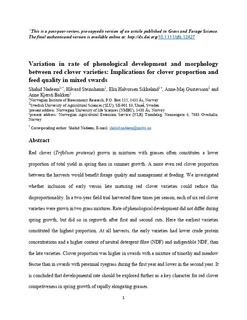| dc.contributor.author | Nadeem, Shahid | |
| dc.contributor.author | Steinshamn, Håvard | |
| dc.contributor.author | Sikkeland, Elin Halvorsen | |
| dc.contributor.author | Gustavsson, Anne-Maj | |
| dc.contributor.author | Bakken, Anne Kjersti | |
| dc.date.accessioned | 2019-10-14T12:38:59Z | |
| dc.date.available | 2019-10-14T12:38:59Z | |
| dc.date.created | 2019-05-31T17:10:54Z | |
| dc.date.issued | 2019-05-28 | |
| dc.identifier.citation | Grass and Forage Science. 2019, 74 (3), 403-414. | nb_NO |
| dc.identifier.issn | 0142-5242 | |
| dc.identifier.uri | http://hdl.handle.net/11250/2622010 | |
| dc.description.abstract | Red clover (Trifolium pratense) grown in mixtures with grasses often constitutes a lower proportion of total yield in spring than in summer growth. A more even red clover proportion between the harvests would benefit forage quality and management at feeding. We investigated whether inclusion of early versus late‐maturing red clover varieties could reduce this disproportionality. In a two‐year field trial harvested three times per season, each of six red clover varieties was grown in two grass mixtures. Rate of phenological development did not differ during spring growth, but did so in regrowth after first and second cuts. Here, the earliest varieties constituted the highest proportion. At all harvests, the early varieties had lower crude protein concentrations and a higher content of neutral detergent fibre (NDF) and indigestible NDF than the late varieties. Clover proportion was higher in swards with a mixture of timothy and meadow fescue than in swards with perennial ryegrass during the first year and lower in the second year. It is concluded that developmental rate should be explored further as a key character for red clover competiveness in spring growth of rapidly elongating grasses. | nb_NO |
| dc.language.iso | eng | nb_NO |
| dc.rights | Attribution-NonCommercial-NoDerivatives 4.0 Internasjonal | * |
| dc.rights.uri | http://creativecommons.org/licenses/by-nc-nd/4.0/deed.no | * |
| dc.subject | Clover proportion | nb_NO |
| dc.subject | Forage quality | nb_NO |
| dc.subject | Grass swards | nb_NO |
| dc.subject | Phenology | nb_NO |
| dc.subject | Trifolium pratense | nb_NO |
| dc.title | Variation in rate of phenological development and morphology between red clover varieties: Implications for clover proportion and feed quality in mixed swards | nb_NO |
| dc.type | Journal article | nb_NO |
| dc.type | Peer reviewed | nb_NO |
| dc.description.version | acceptedVersion | nb_NO |
| dc.rights.holder | © 2019 John Wiley & Sons Ltd | nb_NO |
| dc.subject.nsi | VDP::Landbruks- og Fiskerifag: 900::Landbruksfag: 910::Fôring: 918 | nb_NO |
| dc.subject.nsi | VDP::Landbruks- og Fiskerifag: 900::Landbruksfag: 910 | nb_NO |
| dc.subject.nsi | VDP::Landbruks- og Fiskerifag: 900::Landbruksfag: 910::Planteforedling, hagebruk, plantevern, plantepatologi: 911 | nb_NO |
| dc.source.pagenumber | 403-414 | nb_NO |
| dc.source.volume | 74 | nb_NO |
| dc.source.journal | Grass and Forage Science | nb_NO |
| dc.source.issue | 3 | nb_NO |
| dc.identifier.doi | 10.1111/gfs.12427 | |
| dc.identifier.cristin | 1701950 | |
| dc.relation.project | NIBIO - Norsk institutt for bioøkonomi: 130175 | nb_NO |
| dc.relation.project | Norges forskningsråd: 225330 | nb_NO |
| cristin.unitcode | 7677,1,0,0 | |
| cristin.unitname | Divisjon for matproduksjon og samfunn | |
| cristin.ispublished | true | |
| cristin.fulltext | postprint | |
| cristin.qualitycode | 1 | |

